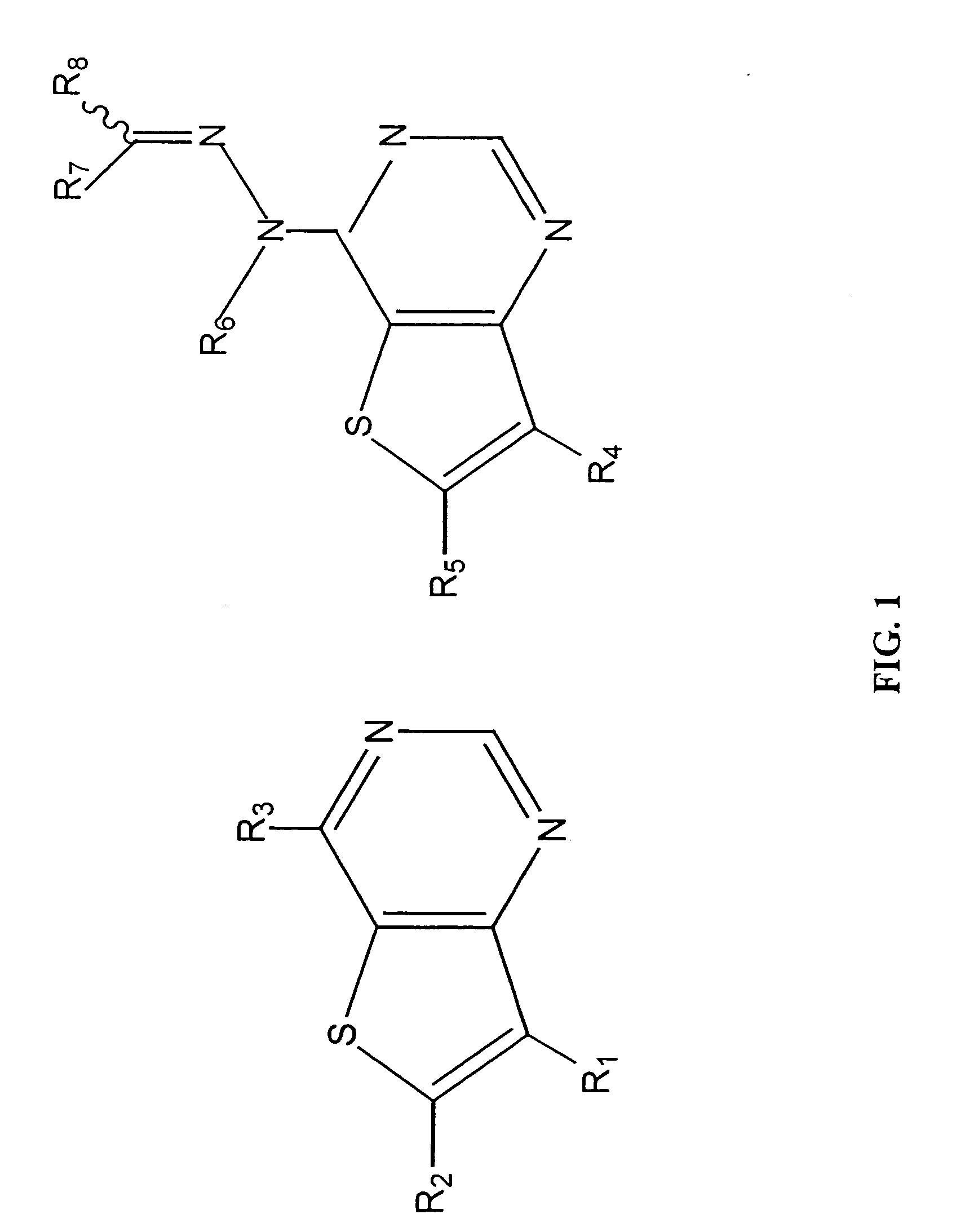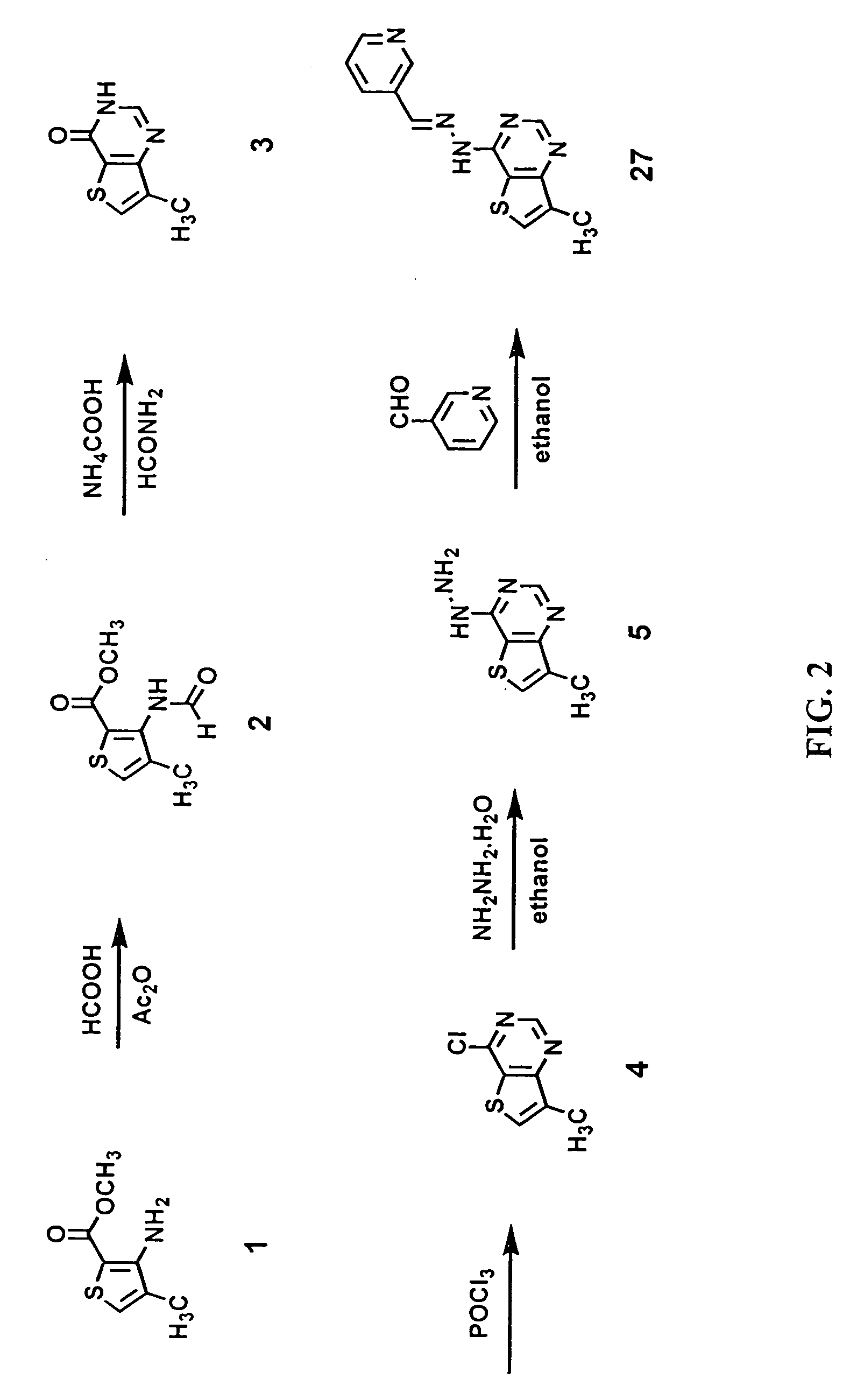Thienopyrimidine-based inhibitors of the src family
a technology of thienopyrimidine and inhibitors, applied in the field of thienopyrimidine-based inhibitors of the src family, can solve the problems of small-molecule inhibitors
- Summary
- Abstract
- Description
- Claims
- Application Information
AI Technical Summary
Benefits of technology
Problems solved by technology
Method used
Image
Examples
example 1
Synthesis of 3-Pyridinecarboxaldehyde(7-methylthieno[3,2-d]pyrimidin-4-yl)hydrazone (27).
[0187]FIG. 2 shows a schematic view of hte synthesis of 3-pyridinecarboxaldehyde(7-methylthieno[3,2-d]pyrimidin-4-yl)hydrazone.
[0188]3-amino-4-methyl-2-thiophenecarboxylic acid methyl ester (1). Commercially available from Lancaster Synthesis Inc., Windham, N.H., USA.
[0189]3-(Formylamino)-4-methyl-2-thiophenecarboxylic acid methyl ester (2). Formic acid (53 mL) was added to acetic anhydride (53 mL) while cooling in an ice bath. Solid methyl 3-amino-4-methyl-2-thiophenecarboxylic acid methyl ester (1, 18.2 g, 0.11 mol) was added to the cold solution in small portions. The cooling bath was removed and the resulting suspension was stirred at room temperature for 4 hours. The reaction mixture was diluted with water (100 mL) and the solid product collected by vacuum filtration to yield 3-(formylamino)4-methyl-2-thiophenecarboxylic acid methyl ester (20.2 g, 95% yield) as a white solid.
[0190]7-Methyl-...
example 2
Synthesis of 3-Pyridinecarboxaldehyde(7-bromothieno[3,2-d]pyrimidin-4-yl)hydrazone (180).
[0196]FIG. 3 shows a schematic view of the synthesis of 3-pyridinecarboxaldehyde(7-bromothieno[3,2-d]pyrimidin-4-yl)hydrazone (180)
[0197]3-Amino-2-thiophenecarboxylic acid methyl ester (7)7. Commercially available from Aldrich Chemical Company, Milwaukee, Wis., USA.
[0198]3-(Formylamino)-2-thiophenecarboxylic acid methyl ester (81). Formic acid (40 mL) was added to acetic anhydride (60 mL) while cooling in an ice bath. Solid 3-amino-2-thiophenecarboxylic acid methyl ester (77, 10.3 g, 66 mmol) was added to the cold solution in small portions. The cooling bath was removed and the resulting suspension was stirred at room temperature for 4 hours. The reaction mixture was diluted with water (100 mL) and the solid product collected by vacuum filtration to yield 3-(formylamino)-2-thiophenecarboxylic acid methyl ester (10.3 g, 85% yield) as a white solid.
[0199]3H-Thieno[3,2-d]pyrimid-4-one (82). To a so...
example 3
Synthesis of 3-Pyridinecarboxaldehyde(6-(3-thienyl)thieno[3,2-d]pyrimidin-4-yl)hydrazone (223).
[0206]FIG. 4 shows a schematic view of the synthesis of 3-pyridinecarboxaldehyde(6-(3-thienyl)thieno[3,2-d]pyrimidin-4-hydrazone (223).
[0207]3-Amino-2-thiophenecarboxylic acid methyl ester (77). Commercially available from Aldrich Chemical Company, Milwaukee, Wis., USA.
[0208]3-(Formylamino)-2-thiophenecarboxylic acid methyl ester (81). Formic acid (40 mL) was added to acetic anhydride (60 mL) while cooling in an ice bath. Solid 3-amino-2-thiophenecarboxylic acid methyl ester (77, 10.3 g, 66 mmol) was added to the cold solution in small portions. The cooling bath was removed and the resulting suspension was stirred at room temperature for 4 hours. The reaction mixture was diluted with water (100 mL) and the solid product collected by vacuum filtration to yield 3-(formylamino)-2-thiophenecarboxylic acid methyl ester (10.3 g, 85% yield) as a white solid.
[0209]3H-Thieno[3,2-d]pyrimid-4-one (82...
PUM
 Login to View More
Login to View More Abstract
Description
Claims
Application Information
 Login to View More
Login to View More - R&D
- Intellectual Property
- Life Sciences
- Materials
- Tech Scout
- Unparalleled Data Quality
- Higher Quality Content
- 60% Fewer Hallucinations
Browse by: Latest US Patents, China's latest patents, Technical Efficacy Thesaurus, Application Domain, Technology Topic, Popular Technical Reports.
© 2025 PatSnap. All rights reserved.Legal|Privacy policy|Modern Slavery Act Transparency Statement|Sitemap|About US| Contact US: help@patsnap.com



